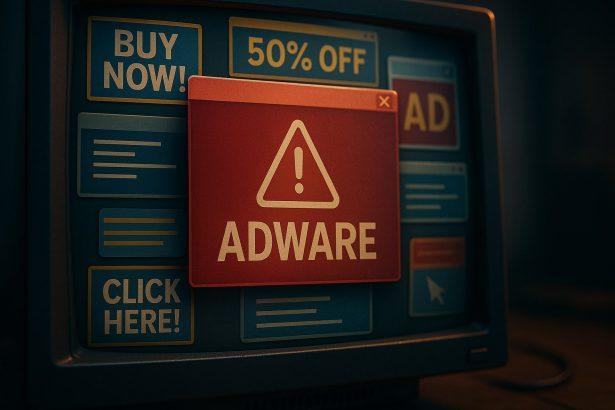A rogue notification page identified on June 23, 2025 has been flooding users with unsolicited ads via the browser’s notification system. Researchers spotted quicksecuretest[.]com after routine inspections of questionable ad networks, noting its sole purpose: trick visitors into enabling spammy push notifications that can lead to scams, malware, and unwanted software.
Threat Overview
Category: Browser notification spam (adware)
What it does: Exploits the browser’s notification API to deliver intrusive ads, redirect users to dubious sites, and promote scams or malware.
In-Depth Analysis
Infection Vector
Most visitors land on quicksecuretest[.]com through redirects injected by rogue advertising networks or deceptive links on compromised websites. Once there, a misleading prompt—often disguised as a CAPTCHA or “Verify you’re human” test—urges the user to click Allow to continue. Granting permission empowers the site to push endless ads directly to the desktop.
Behavioral Profile
- Permission request: Executes
Notification.requestPermission()to gain delivery rights. - Ad delivery: Immediately dispatches notifications with click-bait headlines linking to dubious or malicious pages.
- Persistence: Retains permissions until manually revoked—reopening the site re-prompts if “Remove” was chosen instead of “Block.”
- Escalation: Some notifications download PUAs or trigger further browser redirects to exploit kits or phishing scams.
Risk Assessment
Unchecked, this threat can:
- Harvest data: Track browsing habits and IP geolocation for profiling.
- Propagate malware: Direct victims to installer pages for rogue security tools and trojans.
- Inflict financial harm: Lure users into fake support or phishing scams masquerading as system alerts.
In a recent incident, a small business employee clicked “Allow” and subsequently received instructions to install a “security update” that was actually a banking trojan installer, leading to credential theft.
Artifact Text
Typical permission prompt shown by the rogue page:
“quicksecuretest.com wants to send you notifications”
[Allow] [Block]
Example of the ad-push script snippet:
Notification.requestPermission().then(permission => {
if (permission === 'granted') {
new Notification("Security Alert!", {
body: "Your system is at risk. Click to scan now.",
icon: "/alarm-icon.png"
}).onclick = () => window.open("http://malicious.example.com");
}
});Manual Adware Removal Process (Windows & Mac)
Step 1: Identify and Uninstall Suspicious Applications
For Windows Users
- Open Task Manager by pressing
Ctrl + Shift + Esc. - Navigate to the “Processes” tab and search for unknown or high-resource-consuming processes.
- If you detect anything suspicious, right-click and select “End Task.”
- Go to
Control Panel>Programs>Programs and Features. - Locate and uninstall any unfamiliar programs.
For Mac Users
- Open
Finderand click onApplications. - Identify and move any suspicious applications to the
Trash. - Empty the
Trash. - Check
System Preferences>Users & Groups>Login Itemsfor unknown startup programs and remove them.
Step 2: Remove Malicious Browser Extensions
Google Chrome
- Open Chrome, click
Menu(three dots) >Extensions. - Locate and remove unknown extensions.
- Reset Chrome:
Settings>Reset settings> “Restore settings to their original defaults.”
Mozilla Firefox
- Click
Menu>Add-ons and themes. - Remove suspicious extensions.
- Reset Firefox:
Help>More troubleshooting information> “Refresh Firefox.”
Safari (Mac)
- Open Safari, go to
Preferences>Extensions. - Delete unknown extensions.
- Reset Safari:
History> “Clear History.”
Microsoft Edge
- Click
Menu>Extensions. - Remove any unfamiliar extensions.
- Reset Edge:
Settings>Reset settings> “Restore settings to their default values.”
Step 3: Delete Adware-Associated Files and Folders
For Windows Users
- Press
Win + R, type%AppData%, and press Enter. - Locate and delete suspicious folders.
- Repeat for
%LocalAppData%,%ProgramData%, and%Temp%.
For Mac Users
- Open Finder and press
Shift + Command + G, then enter~/Library/Application Support/. - Remove any suspicious folders.
- Repeat for
~/Library/LaunchAgents/,~/Library/LaunchDaemons/, and~/Library/Preferences/.
Step 4: Flush DNS Cache to Remove Adware Traces
For Windows Users
- Open
Command Promptas Administrator. - Type
ipconfig /flushdnsand press Enter.
For Mac Users
- Open
Terminal. - Enter
sudo killall -HUP mDNSResponderand press Enter.
Step 5: Restart Your System
Perform a reboot to apply the changes and ensure the removal process is complete.
Automatic Adware Removal Using SpyHunter (Windows & Mac)
For an effortless and effective solution, use SpyHunter, a powerful anti-malware tool designed to detect and remove adware completely.
Step 1: Download SpyHunter
Click the link to download SpyHunter: Download SpyHunter Here.
Step 2: Install SpyHunter
Follow the installation guide based on your operating system:
For Windows Users
- Run the downloaded
.exefile. - Follow the installation instructions.
- Launch SpyHunter and allow it to update its malware database.
For Mac Users
- Open the downloaded
.dmgfile. - Drag and drop SpyHunter into
Applications. - Open SpyHunter and let it update its database.
Step 3: Scan and Remove Adware
- Open SpyHunter.
- Click
Start Scan. - Wait for the scan to complete.
- Click
Fix Threatsto remove detected malware.
Step 4: Restart Your Computer
After SpyHunter removes all threats, restart your system to ensure all adware components are fully removed.
Conclusion
Ads by quicksecuretest.com exploit the browser notification feature to deliver relentless, deceptive advertisements—often serving as a gateway to more dangerous scams and malware. Early recognition of the unauthorized permission and swift revocation or removal are essential to halt further intrusion.




